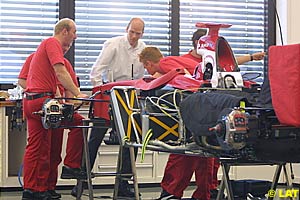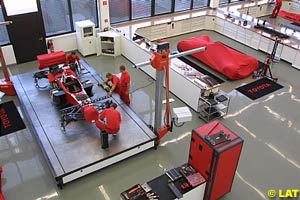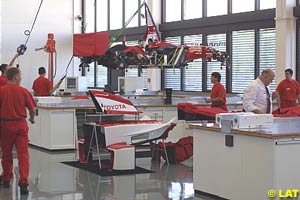
Atlas F1 Technical Writer
Toyota will officially become the 12th team in Formula One next week, on November 15th. Their entry to the sport is intriguing, almost pretentious, but one look at their high-tech, high-profile assembly room shows they mean business. Atlas F1's Will Gray dropped by Cologne, Germany, to see how the boys in Red and White are doing, with just 16 weeks to go before they show up on the grid of the Australian Grand Prix. They may not be fastest out of the box, he says, but they sure know how to build a factory
There will be massive interest and expectation when Toyota arrives on the Grand Prix scene in Australia next year. The giant Japanese marque has already put a conservative tag on their aspirations of Formula One success in the near future, but if their German headquarters are anything to go by, then they are certainly taking things seriously.
But they are definitely going about things the right way. The factory, nestled in an industrial estate off the main route around the beautiful city of Cologne, is an impressive facility, full of state of the art equipment. In fact, two of the top technical men involved, both of whom have, incidentally, spent time at Ferrari's hallowed Maranello base, believe Toyota's new place is one of the best in Formula One.
"Toyota is a state of the art facility," said engine project manager Luca Marmarini, who was lured to the team from Ferrari. "I don't think there are any other facilities to compare to the Toyota one. It is difficult to show to everybody because there is so much that is secret. You can see something, but I think a lot of the secret areas, where a lot of the most important things of our development, you can't see."
Chief designer Gustav Brunner echoed his engine man's views but added that the facility, still under construction in parts, will be even more impressive when it is fully complete. Maranello has been built up over time, Toyota's factory is one fully-integrated facility, designed to house both engine and chassis design, test and manufacture. It will, Brunner believes, be unrivalled.
"The wind tunnel is still under construction so really it is a base for the future. We hope to have it running by the end of this year. It will be too late for the start of the season, but it will probably help mid-season updates to come. In the end, it will be the most modern facility there is in Formula One."
Like all Formula One factories, Toyota's home sits surrounded by buildings associated with all other types of industry. It is a big facility, but it is not immediately impressive. The building is all white, with a glass front entrance, and the red lettering of Toyota is prominently visible from the motorway on the way to the factory. But until you get inside, that is all that makes it stand out from its surroundings.
Massive car parks surround the glistening factory, and the air is of everyday business rather than pomp and circumstance. Of course, Toyota has nothing in the way of trophies to show off in a grand entrance hall. Instead they have models depicting cars that have won other championships for Toyota, and, sitting in pride of place in the centre hallway, is a wind tunnel model of this year's test car, the first Formula One machine the company has ever produced.
Even more intriguing is the fact that despite a slight bias on German-speaking employees, the factory language is English. No staff can communicate in another tongue, even if both are German. But that is, once again, part of the unity that embodies Toyota. Such unity is essential if they are to succeed in getting to the levels their former-Ferrari management expect - and it is shown clearly by a brief stroll around the factory itself.
Expansive and wide-open corridors lead between massive rooms, each neatly separated out. The massive race bays house a maximum of six cars, neatly, lined up in a row, each with its own hub, including exhaust extraction, which allows the team to test engine and electronic installation at any time.
Like all the departments within the massive factory, there is plenty of space, and in the design office, just along the corridor, the design teams are separated into chassis and engine sections. Both are close to each other, however, so any links that need to be made between the two projects are easy.
The team has three dynos, all of which can run engines 24-hours per day if required. In the soundproof rooms, engines can be revved to the maximum, or put through computer-run programmes which simulate track conditions on any Grand Prix circuit around the globe.
Much of the work in this area is done to run in the engines and prepare them for the coming race or test, but about one third of the time spent in the test cells is used to develop new parts and test them to the limit. That is why the windows into the bays are bulletproof - because in innovation things often go wrong.
Around the rest of the departments, there are plenty of high-tech gadgets. One of the most impressive is a rapid prototyping machine, fast becoming an essential part of the Formula One factory, which uses lasers to build up parts from a resin material and test them in the wind tunnel.
However, despite the facilities, the test car is still five seconds off the pace of last year's pole position times. There will be a lot of work involved in changing that. Neither man wants to show big ambitions before their ultimate test, but Marmarini believes at least having his engine project under the same roof as Brunner's chassis team will help them move forward.
"Ferrari was definitely winning last year because of this big integration between engine and chassis," he said. "Toyota, having everything under the same roof, theoretically will have a similar possibility as well, and this could definitely be an advantage for us.
"It is difficult to make a comparison (to Ferrari) at the moment. If you want to do Formula One you need hundreds of people but that still doesn't mean that you will win. But, at the very least, you need a big amount of investment, a lot of people and huge facilities."
Toyota has all of that, but comparisons can only be made when they get on the grid. There is a counter on the wall in one of the busy workshops, notching down every day there is to go until the team makes their debut in Australia next year. There is a lot to do, and time is ticking fast.
 The impression of Toyota, in some ways, is of a surprisingly disorganised team considering their size and the backing they have. But then, you must remember that they have never done this before. Every new media day, every new test, and, come Australia, every new race is another step on the learning curve that will provide them with new experience, new challenges, and, hopefully for them, new solutions.
The impression of Toyota, in some ways, is of a surprisingly disorganised team considering their size and the backing they have. But then, you must remember that they have never done this before. Every new media day, every new test, and, come Australia, every new race is another step on the learning curve that will provide them with new experience, new challenges, and, hopefully for them, new solutions.
 "We have very good facilities but here we are still building," said Brunner. "It is not yet the end product. It is very good so far but things are changing daily, it is getting bigger every day.
"We have very good facilities but here we are still building," said Brunner. "It is not yet the end product. It is very good so far but things are changing daily, it is getting bigger every day.
 The decision to locate in Germany was a brave but calculated move for Toyota. Setting up a team in Japan would have been rather impractical, but Toyota has gone against the trend of a middle England location, and in doing so has become a truly cosmopolitan team. Many of the staff in the factory are German, but because of the international nature of Formula One, there are plenty of other nationalities involved, and, somewhat strangely, few Japanese.
The decision to locate in Germany was a brave but calculated move for Toyota. Setting up a team in Japan would have been rather impractical, but Toyota has gone against the trend of a middle England location, and in doing so has become a truly cosmopolitan team. Many of the staff in the factory are German, but because of the international nature of Formula One, there are plenty of other nationalities involved, and, somewhat strangely, few Japanese.
 The proximity of the engine and car build processes runs through from the design room into final creation, where the impressive engine manufacture bays, in which the team rolls its own metal for the exhausts to ensure the best accuracy, sit alongside carbon fibre moulding bays where the chassis are manufactured.
The proximity of the engine and car build processes runs through from the design room into final creation, where the impressive engine manufacture bays, in which the team rolls its own metal for the exhausts to ensure the best accuracy, sit alongside carbon fibre moulding bays where the chassis are manufactured.
 The model shop, which is, of course, also on site, lies just around the corner from the most important area to which it is linked - the wind tunnel. A 50 percent sized facility, which Brunner has praised profusely, will be another essential on-site section of the factory, and should provide rapid flow of development parts through the system when it is up and running.
The model shop, which is, of course, also on site, lies just around the corner from the most important area to which it is linked - the wind tunnel. A 50 percent sized facility, which Brunner has praised profusely, will be another essential on-site section of the factory, and should provide rapid flow of development parts through the system when it is up and running.
Please Contact Us for permission to republish this or any other material from Atlas F1.
|
Volume 7, Issue 45
Articles
Toyota's House of Dreams
Reflections from the F1 Paddock
Columns
Elsewhere in Racing
The F1 FAQ
Bookworm Critique
The Weekly Grapevine
> Homepage |